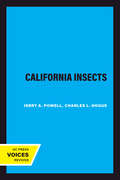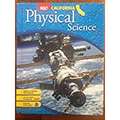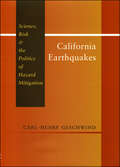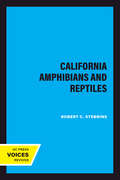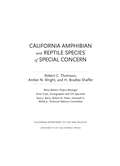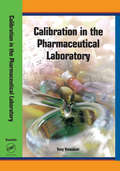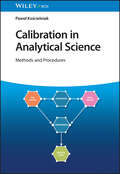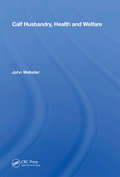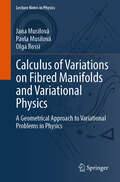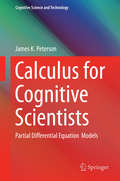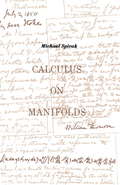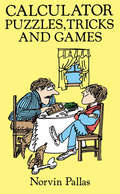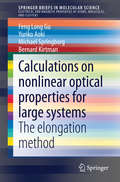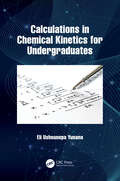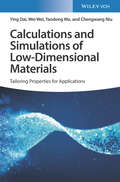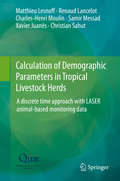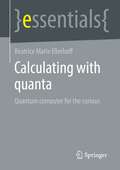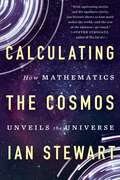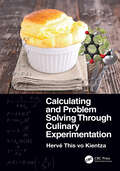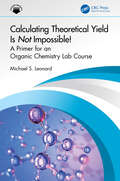- Table View
- List View
California Insects: Second Edition (California Natural History Guides #44)
by Jerry A. Powell Charles L. HogueCalifornia has a vast number of insect species: estimates run 30,000-35,000 or more, and even in the better known groups, new species occasionally are discovered. This volume is the first attempt in more than half a century to summarize knowledge of this rich insect fauna, and the first work ever to provide a field guide for beginning students, and the nonspecialist reader. It selects about 600 of the more characteristic kinds of insects to represent the huge variety known. Most of these are conspicuous kinds often noticed in cities or in natural areas by gardeners, hikers, fishermen, etc. For each insect, distinguishing features of its appearance, features of its biology, and its geographical distribution in California are summarized: and an illustration (photograph or drawing) is given of the adult or some other stage.California Insects will serve as a convenient, compact introduction to the identification and understanding of these often strange and fascinating creatures. Used with other information sources cited in the text, it provides the student, collector, or naturalist a means of efficiently developing knowledge of specialized groups of insects.
California HMH Science Dimensions™, Designated ELD: The Living Earth, Student Workbook
by Houghton Mifflin HarcourtNIMAC-sourced textbook
California Focus on Physical Sciences InterActive Reader
by Mcdougal LittellFocuses on Physical Science -- the Interactive Reader makes reading science fun, exciting and easy to read
California Earthquakes: Science, Risk, and the Politics of Hazard Mitigation
by Carl-Henry GeschwindWinner of the Book Prize of the Forum for the History of Science in America from the History of Science SocietyIn 1906, after an earthquake wiped out much of San Francisco, leading California officials and scientists described the disaster as a one-time occurrence and assured the public that it had nothing to worry about. California Earthquakes explains how, over time, this attitude changed, and Californians came to accept earthquakes as a significant threat, as well as to understand how science and technology could reduce this threat.Carl-Henry Geschwind tells the story of the small group of scientists and engineers who—in tension with real estate speculators and other pro-growth forces, private and public—developed the scientific and political infrastructure necessary to implement greater earthquake awareness. Through their political connections, these reformers succeeded in building a state apparatus in which regulators could work together with scientists and engineers to reduce earthquake hazards. Geschwind details the conflicts among scientists and engineers about how best to reduce these risks, and he outlines the dramatic twentieth-century advances in our understanding of earthquakes—their causes and how we can try to prepare for them.Tracing the history of seismology and the rise of the regulatory state and of environmental awareness, California Earthquakes tells how earthquake-hazard management came about, why some groups assisted and others fought it, and how scientists and engineers helped shape it.
California Earth Science Middle School
by Macmillan Mcgraw-HillScience is a way of understanding the world around us. The work of scientists often begins when scientists ask questions about something they observe. Asking and answering questions Is the basis of inquiry.
California Ciencias: Student Edition Grade 5 2008 (Harcourt School Publishers)
by Harcourt School Publishers HspCalifornia Amphibians and Reptiles: Revised Edition (California Natural History Guides #31)
by Robert C. StebbinsThis title is part of UC Press's Voices Revived program, which commemorates University of California Press’s mission to seek out and cultivate the brightest minds and give them voice, reach, and impact. Drawing on a backlist dating to 1893, Voices Revived makes high-quality, peer-reviewed scholarship accessible once again using print-on-demand technology. This title was originally published in 1972.This title is part of UC Press's Voices Revived program, which commemorates University of California Press’s mission to seek out and cultivate the brightest minds and give them voice, reach, and impact. Drawing on a backlist dating to 1893, Voices Revived</DIV
California Amphibian and Reptile Species of Special Concern
by Robert C. ThomsonOne of the most important hotspots of herpetological biodiversity in the United States, California is home to many endemic amphibians and reptiles found nowhere else on earth. Many of these taxa have unique ecological and morphological specializations, and their management is an important conservation challenge. Increasing climate change impacts, human development, and extreme drought mean many of these species face an ever-greater risk of extinction. California Amphibian and Reptile Species of Special Concern provides an up-to-date synthesis of the current state of knowledge regarding the biology and conservation risks faced by 45 of California's most sensitive amphibian and reptile species. With the goal of enhancing management based on the best available science, the authors developed a novel set of risk metrics to identify special concern species and the threats they face, including population declines, range size and restrictions, and ecological specializations and niche restrictions. In addition to detailed species accounts, this book provides a quantitative analysis of the conservation status and pressing management issues facing individual species and the state's amphibian and reptile fauna as a whole. The volume focuses on identifying threats, concrete recommendations for management and recovery, and future research needs. The text is complemented by detailed distribution maps, color photos, and graphs. Written in nontechnical language, California Amphibian and Reptile Species of Special Concern will be a valuable resource to a broad range of users from resource managers, field biologists, and academic herpetologists to students and recreational naturalists. Published in association with the California Department of Fish and Wildlife.
Calibration in the Pharmaceutical Laboratory
by Tony KowalskiIncreasingly, pharmaceutical scientists must not only be specialists in their field but must also be familiar with legislation that governs the use of equipment in their industry. The regulation of test and measuring equipment changes continually as new regulations are introduced and new equipment is developed. Calibration in the Pharmaceutical Lab
Calibration in Analytical Science: Methods and Procedures
by Paweł KościelniakCalibration in Analytical Science Designed to help analytical chemists save time and money by selecting the best calibration method in a quality control, substance monitoring, or research setting Univariate analytical calibration is a vital step in every chemical procedure that involves determining the identity or concentration of a particular substance. Depending on the type of instrument and measurement, analytical chemists need to follow different calibration strategies and protocols to ensure their instruments yield accurate readings. Calibration in Analytical Science systematically classifies and describes a wide range of calibration methods and procedures based on mathematical and empirical models for use in qualitative and quantitative analysis. Focusing on the chemical aspects of analytical calibration, this much-needed reference uses a set of equipment-independent terms and definitions that are easily transferable to the calibration strategies of any analytical process. The theoretical basis for calibration of each analytical mode is described and applied to common analytical tasks of increasing levels of difficulty and complexity. Throughout the book, the author illustrates how to combine different calibration approaches to create new calibration strategies with extended capabilities. Describes different calibration methods and procedures for determining the nature and quantity of sample components in different ways Classifies various calibration methods in both qualitative and quantitative analysis Demonstrates how the random and systematic errors of an analytical method can be minimized by the proper calibration strategy Discusses current theoretical and methodological questions in calibration research Highlights how calibration approaches can diagnose, evaluate, and eliminate analytical errors Includes a concluding chapter on the contribution of calibration to the greening of analytical chemistry Calibration in Analytical Science: Methods and Procedures is a must-have reference for analytical chemists working in academia and industry, chemists of various specialties involved in chemical analysis, and advanced undergraduate and graduate students taking courses in advanced analytical chemistry.
Calf Husbandry, Health And Welfare
by John WebsterToo many calves die young or fail to survive at the cost of enormous financial loss and suffering. Good calf performance and health can be achieved if the stockmanship is good. Today this implies not only a sense of care but a thorough science-based education. Aimed at both students and stockmen, this book explains the scientific basis of calf-rear
Calculus of Variations on Fibred Manifolds and Variational Physics: A Geometrical Approach to Variational Problems in Physics (Lecture Notes in Physics #1033)
by Jana Musilová Pavla Musilová Olga RossiThis book presents modern variational calculus in mechanics and field theories with applications to theoretical physics. It is based on modern mathematical tools, specifically fibred spaces and their jet prolongations, which operate with vector fields and differential forms on foundational structures. The book systematically explains Lagrangian and Hamiltonian mechanics and field theory, with a focused exploration of the underlying structures. Additionally, it addresses the well-known inverse problem of calculus of variations and provides examples illustrating key variational physical theories. The text is complemented by solved examples from physics and includes exercises designed to help readers master the subject. Aimed at PhD students, postdocs, and interested researchers, this book assumes prior knowledge of mathematical analysis, linear and multilinear algebra, as well as elements of general and theoretical physics for effective engagement with the discussion.
Calculus for Cognitive Scientists: Partial Differential Equation Models (Cognitive Science and Technology #0)
by James K. PetersonThis book provides a self-study program on how mathematics, computer science and science can be usefully and seamlessly intertwined. Learning to use ideas from mathematics and computation is essential for understanding approaches to cognitive and biological science. As such the book covers calculus on one variable and two variables and works through a number of interesting first-order ODE models. It clearly uses MatLab in computational exercises where the models cannot be solved by hand, and also helps readers to understand that approximations cause errors - a fact that must always be kept in mind.
Calculus On Manifolds
by Michael SpivakThis little book is especially concerned with those portions of "advanced calculus" in which the subtlety of the concepts and methods makes rigor difficult to attain at an elementary level. The approach taken here uses elementary versions of modern methods found in sophisticated mathematics. The formal prerequisites include only a term of linear algebra, a nodding acquaintance with the notation of set theory, and a respectable first-year calculus course (one which at least mentions the least upper bound (sup) and greatest lower bound (inf) of a set of real numbers). Beyond this a certain (perhaps latent) rapport with abstract mathematics will be found almost essential.<P><P> Advisory: Bookshare has learned that this book offers only partial accessibility. We have kept it in the collection because it is useful for some of our members. To explore further access options with us, please contact us through the Book Quality link on the right sidebar. Benetech is actively working on projects to improve accessibility issues such as these.
Calculator Puzzles, Tricks and Games (Dover Children's Science Books)
by Norvin PallasPerform amazing feats of mathematical magic, answer clever riddles, and much more with this book and a handy pocket calculator. Scores of brain-teasers, puzzles, mathematical oddities, games, and recreations to fill dozens of hours with fun and excitement. Answers to problems.
Calculations on nonlinear optical properties for large systems: The elongation method (SpringerBriefs in Molecular Science)
by Feng Long Gu Yuriko Aoki Michael Springborg Bernard KirtmanFor design purposes one needs to relate the structure of proposed materials to their NLO (nonlinear optical) and other properties, which is a situation where theoretical approaches can be very helpful in providing suggestions for candidate systems that subsequently can be synthesized and studied experimentally. This brief describes the quantum-mechanical treatment of the response to one or more external oscillating electric fields for molecular and macroscopic, crystalline systems. To calculate NLO properties of large systems, a linear scaling generalized elongation method for the efficient and accurate calculation is introduced. The reader should be aware that this treatment is particularly feasible for complicated three-dimensional and/or delocalized systems that are intractable when applied to conventional or other linear scaling methods.
Calculations in Chemical Kinetics for Undergraduates
by Eli Usheunepa YunanaCalculations in Chemical Kinetics for Undergraduates aims to restore passion for problem solving and applied quantitative skills in undergraduate chemistry students. Avoiding complicated chemistry jargon and providing hints and step wise explanations in every calculation problem, students are able to overcome their fear of handling mathematically applied problems in physical chemistry. This solid foundation in their early studies will enable them to connect fundamental theoretical chemistry to real experimental applications as graduates. Additional Features Include: Contains quantitative problems from popular physical chemistry references. Provides step by step explanations are given in every calculation problem. Offers hints to certain problems as "points to note" to enable student comprehension. Includes solutions for all questions and exercises. This book is a great resource for undergraduate chemistry students however, the contents are rich and useful to even the graduate chemist that has passion for applied problems in physical chemistry of reaction Kinetics.
Calculations and Simulations of Low-Dimensional Materials: Tailoring Properties for Applications
by Wei Wei Ying Dai Yandong Ma Chengwang NiuCalculations and Simulations of Low-Dimensional Materials A comprehensive guide to methods for calculating and simulating the properties of low-dimensional materials Two-dimensional materials are those, such as graphene and 2D oxides, whose thickness is so small as to approach the atomic scale. Potential applications for these materials exist in an enormous range of scientific and industrial fields. A previous era of low-dimensional materials focused on direct experimentation to demonstrate the properties, reactions, and potential applications of these materials; however, in recent years, calculation and simulation have been shown to have considerable predictive power, reducing the period between design and deployment of these potentially critical materials. Calculations and Simulations of Low-Dimensional Materials offers the first comprehensive survey of this exciting new approach to low-dimensional materials. It guides readers through the foundational physics and through a range of calculation and simulation methods, each with different predictive capacities. Mastery of these methods will enable readers to narrowly tailor the properties of particular materials towards real-world applications, providing confidence in the underlying mechanics and in the range of possible outcomes. Calculations and Simulations of Low-Dimensional Materials readers will also find: Broad coverage of material properties, including electronic, spin, magnetic, photonic, optical, electrochemical and transport properties Discussion of potential applications in areas such as electronics, spintronics, and valleytronics Examination of further potential applications regarding quantum Hall phase, photonics, optoelectronics, multiferroic, and photocatalysis Calculations and Simulations of Low-Dimensional Materials is a useful reference for materials scientists, electrochemists, inorganic chemists, physical chemists, photochemists, and the libraries that support these professions.
Calculation of Demographic Parameters in Tropical Livestock Herds: A discrete time approach with LASER animal-based monitoring data
by Matthieu Lesnoff Renaud Lancelot Charles-Henri Moulin Samir Messad Xavier Juanès Christian SahutHaving indicators to assess the effect of zootechnical, sanitary, economic or political intervention or the impact of environmental risks makes it possible to draw up strategies for improving domestic animal populations. This handbook is a compilation of the main concepts relating to the definition and calculation of demographic rates for largely non-intensive tropical animal farms. It is intended to be educational, and should help students, technicians, engineers, researchers and development staff to understand the definitions and formulas encountered in the literature more clearly and make them more self-sufficient in terms of analyses.
Calculating with quanta: Quantum computer for the curious (essentials)
by Beatrice Marie EllerhoffThis essential creates a lively and vivid understanding of the processes in quantum computers. It explores the quantum phenomena of entanglement and superposition and how they can be used for computing. Coding of information, explanation of simple algorithms, and possible applications are shown. A glossary at the end of the essentials explains the most important terms.
Calculating the Cosmos: How Mathematics Unveils the Universe
by Ian StewartA prize-winning popular science writer uses mathematical modeling to explain the cosmos.In Calculating the Cosmos, Ian Stewart presents an exhilarating guide to the cosmos, from our solar system to the entire universe. He describes the architecture of space and time, dark matter and dark energy, how galaxies form, why stars implode, how everything began, and how it's all going to end. He considers parallel universes, the fine-tuning of the cosmos for life, what forms extraterrestrial life might take, and the likelihood of life on Earth being snuffed out by an asteroid.Beginning with the Babylonian integration of mathematics into the study of astronomy and cosmology, Stewart traces the evolution of our understanding of the cosmos: How Kepler's laws of planetary motion led Newton to formulate his theory of gravity. How, two centuries later, tiny irregularities in the motion of Mars inspired Einstein to devise his general theory of relativity. How, eighty years ago, the discovery that the universe is expanding led to the development of the Big Bang theory of its origins. How single-point origin and expansion led cosmologists to theorize new components of the universe, such as inflation, dark matter, and dark energy. But does inflation explain the structure of today's universe? Does dark matter actually exist? Could a scientific revolution that will challenge the long-held scientific orthodoxy and once again transform our understanding of the universe be on the way? In an exciting and engaging style, Calculating the Cosmos is a mathematical quest through the intricate realms of astronomy and cosmology.
Calculating and Problem Solving Through Culinary Experimentation
by Hervé This vo KientzaWhile many books proliferate elucidating the science behind the transformations during cooking, none teach the concepts of physics chemistry through problem solving based on culinary experiments as this one by renowned chemist and one of the founders of molecular gastronomy. Calculating and Problem Solving Through Culinary Experimentation offers an appealing approach to teaching experimental design and scientific calculations. Given the fact that culinary phenomena need physics and chemistry to be interpreted, there are strong and legitimate reasons for introducing molecular gastronomy in scientific curriculum. As any scientific discipline, molecular gastronomy is based on experiments (to observe the phenomena to be studied) and calculation (to fit the many data obtained by quantitative characterization of the studied phenomena), but also for making the theoretical work without which no real science is done, including refuting consequences of the introduced theories. Often, no difficult calculations are needed, and many physicists, in particular, make their first steps in understanding phenomena with very crude calculations. Indeed, they simply apply what they learned, before moving to more difficult math. In this book, the students are invited first to make simple experiments in order to get a clear idea of the (culinary) phenomena that they will be invited to investigate, and then are asked simple questions about the phenomena, for which they have to transform their knowledge into skills, using a clear strategy that is explained throughout. Indeed, the is "problem solving based on experiments", and all this about food and cooking. Key Features: • Introduces readers to tips for experimental work • Shows how simple scientific knowledge can be applied in understanding questions • Provides a sound method ("strategy") for calculation in physics and chemistry • Presents important definitions and laws for physical chemistry • Gives confidence in one’s calculation skill and problem solving skills • Explore physical and chemical phenomena that occur during cooking A unique mix of culinary arts and correct calculations, this book is useful to students as well as professors in chemistry, physics, biology, food science and technology.
Calculating X-ray Tube Spectra: Analytical and Monte Carlo Approaches (ISSN)
by Pedro Andreo Gavin Poludniowski Artur OmarCalculating x-ray tube spectra provides a comprehensive review of the modelling of x-ray tube emissions, with a focus on medical imaging and radiotherapy applications. It begins by covering the relevant background, before discussing modelling approaches, including both analytical formulations and Monte Carlo simulation. Historical context is provided, based on the past century of literature, as well as a summary of recent developments and insights. The book finishes with example applications for spectrum models, including beam quality prediction and the calculation of dosimetric and image-quality metrics.This book will be a valuable resource for postgraduate and advanced undergraduate students studying medical radiation physics, in addition to those in teaching, research, industry and healthcare settings whose work involves x-ray tubes.Key Features: Covers simple modelling approaches as well as full Monte Carlo simulation of x-ray tubes. Bremsstrahlung and characteristic contributions to the spectrum are discussed in detail. Learning is supported by free open-source software and an online repository of code. An online repository of the code that accompanies this book can be found here: https://bitbucket.org/caxtus
Calculating Theoretical Yield Is Not Impossible!: A Primer for an Organic Chemistry Lab Course
by Michael S. LeonardCalculating theoretical and percent yield is a fundamental skill for the laboratory. This book primarily targets Organic Chemistry Laboratory courses at the high school or college and university level, as a supplemental resource to help students master this skill. It begins with simple examples from everyday life, demonstrates the importance of balancing the equation, addresses the role of the mole in these computations, discusses different types of liquids, considers the role of significant figures, and culminates with the planning of syntheses. There are suggestions for further reading as well as practice problems and questions to ensure mastery. Begins with examples from everyday life that enable students to understand the concepts of theoretical and percent yield before applying those concepts to the laboratory. Addresses the necessity of balancing the reaction equation, the centrality of the mole in these calculations, and the role of significant figures in reporting the answer. Explains how to approach the calculations when using neat liquids or solutions. The culmination of this text is the use of the same thought processes to plan the amounts of reactants needed for syntheses of desired quantities of product. All of the problems in the book include detailed solutions with accompanying text to explain the answers and ancillaries also include suggestions for further reading.
